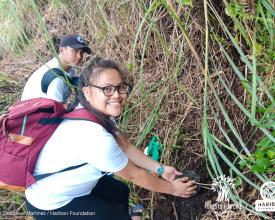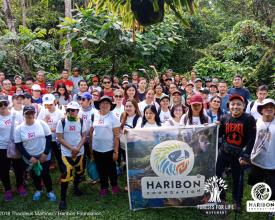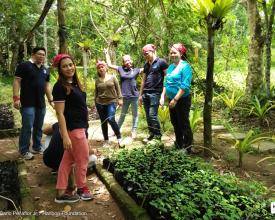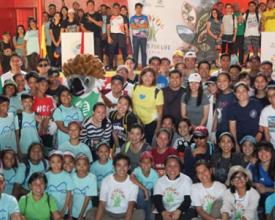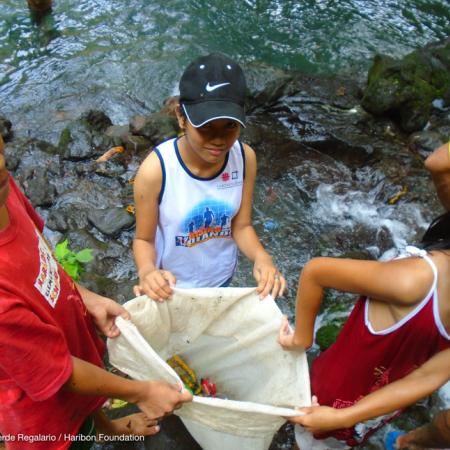
Forests for Life Movement: Restoring Forests through stakeholder engagement and empowerment using native trees
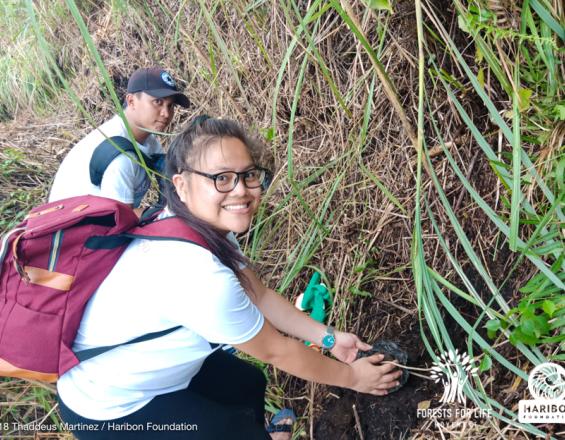
Forests for Life Movement is an environmental conservation movement that provides solution to the continuous decline of forest cover in the Philippines. It used to be called Rainforestation Organization and Advocates (ROAD) to 2020, brought to life in November 2005 during the National Consultation on Rainforest Restoration. It was relaunched onJuly 14, 2018 to mobilize support from individuals and organizations, sharing opportunities for taking collective action. It envisions to bring back biodiversity using native forest tree species to sustain provision of ecological goods and services. It prioritized Protected Areas, and local stakeholders in these areas were partnered and capacitated to ensure success of the restoration efforts. Lastly, it also lobbied and continued to support the implementation of various government policies that are in line with the country’s commitment to various international conventions for the environment and to the principle of Sustainable Forest Management.
Contexte
Challenges addressed
FFL aims to restore Philippine Rainforests using native trees. Forest degradation is at its lowest, where only 6.84M has. or 22.8% of the Philippines’ total land area is left covered with forest (DENR-FMB 2012). This is behind the minimum 40% or 12M has. (Pulhin, et al. 2006) requirement to support water-related functions, and even more behind the 54% requirement (Sajise, 1996) to provide other services.
Other challenges of the solution are:
- Weak enforcement of environmental laws and policies in the restoration site
- Land claim issues at the site after or during the restoration efforts, in spite of the community consultations and other social preparations
- Sustainability of the site and partners’ efforts after the 3 years provision of financial incentives or upon turn-over of the site, either to NGAs or LGUs
- Need for a continuous Education and Public Awareness Campaign to ensure lasting protection by the stakeholders
- Farming practices near the restoration sites are not bio-diversity friendly
Emplacement
Traiter
Summary of the process
The building blocks complement each other. These are all vital components of the whole solution. The FFL Movement acts both as the facilitating factor and the solution itself that drove the different sectors of the society to have collective efforts to bring back the Philippine forests for the benefit of all stakeholders. The participative selection of restoration areas within the KBAs allowed for the implementation of the actual reforestation to be operational smoothly because the stakeholders agreed to the strategies and intervention, ensuring a more cooperative environment. The AAS program facilitates the actual implementation of forest restoration activities, which involves direct provision of financial and volunteer support from corporations and individuals- through donations and volunteer works. Lastly, the community approach to maintenance empowered the community partners and allowed them to accept accountability to ensure successful growth of the trees. By securing the livelihood of the local partners, they were more willing to take on their roles
Building Blocks
Forests for Live Movement (Network Building)
Forests For Life is an environmental conservation movement/network that envisions the restoration of Philippine rainforests using native tree species with support from various sectors. It began as a movement called ROAD to 2020, which worked with communities, local government units, indigenous peoples, academe, like-minded groups and the youth to bring back the lost forests. Through the movement, Haribon was able to empower local communities, build native tree nurseries, provide guidance in establishing conservation areas, influence policies, organize tree planting drives and encourage the public to take part in citizen science. To date, 13,416 Volunteers and 14 community partners in 30 Municipalities have been mobilized, which significantly shows raised awareness on biodiversity.
Enabling factors
A Rain Forest Restoration Initiative (RFRI) Network was formed during the National Consultation on Rainforest Restoration in November 2005, which has initiated forest restoration efforts since 2006; Government Policy-Memorandum Circular 2004- 06; Executive Order 23 and 26; Support from Local Government Units, Peoples Organizations; Corporate and Individual donations
Lesson learned
The clear targets of sustaining the ecological goods and services of our forests for the present and succeeding generations can only be achieved if we restore our forests using native trees. Engagement from the different sectors of the society is vital. This can be achieved if stakeholders share the same vision, and understand how biodiversity is interconnected and affects their everyday lives. It is important that the corporate sector and local government units understand their big role in providing assistance to the different stakeholders, which in return favors the sustainability not only of the local communities, but of the bigger population. Government priorities and policies that favor the improvement of livelihood and capacities of the communities will help in attaining success of restoration initiatives
Participative selection of restoration areas within Key Biodiversity Areas (KBAs)
It is imperative that restoration sites are selected in a participative approach. These are selected in consultation with various government agencies such as the DENR, LGUs and other agencies. Hand-in- hand with the site selection is the People's Organization selection. Also, selection of the site in identified Key Biodiversity Area supports the government priorities to ensure long term solutions in mitigating climate change.
Enabling factors
It was critical that sites and community partners follow an eligibility criteria
Lesson learned
Based on the experiences of Haribon, it is foremost and best to carefully select restoration sites. The sites must be eligible. Eligible sites are public lands identified by the LGUs and DENR such as forest lands, national parks and/or protected areas, watershed areas, mangrove areas, Community-based Forest Management Agreement (CBFMA) areas and penal farms. The use of correct species of native trees that dominantly and aggressively thrives in a particular restoration site is very vital in the growth and survival of seedlings
Community-based Maintenance for Sustainable Livelihood
The Community-based maintenance began by educating and capacitating the partner communities that will be in-charge in ensuring the successful survival of the trees in the rainforestation. The capacity building program of the local partner community entailed teaching the participants with farming techniques, monitoring tools and organizational development skills to ensure a sustainable partnership and high survival of the trees planted.
Alongside the capacity building of the community partners is the opportunity to earn additional income, not only from the activities on restoration, but also facilitates other livelihood activities aligned with the objectives of the movement like seedling production. This substitutes the risk of the local community to engage or allow illegal activities that provides them extra income. Furthermore, the government, through the Department of Environment and Natural Resources, tapped people’s organizations to produce native tree seedlings in support of the National Greening Program. This contributed to a more stable and continued form of livelihood to the project’s community beneficiaries.
Enabling factors
Partnership building with key stakeholders to ensure participatory approach in achieving a dignified Ecosystem and human well-being, by having a well restored forests. Farmers and forest dependent communities were assisted and capacitated because of their crucial role as the main actors on the ground. By providing the community proper restoration technology and promotion of biodiversity conservation and biodiversity friendly agriculture, the ecological benefits that need to be sustained has a higher probability of being achieved.
Lesson learned
The selection of eligible community partner is also very vital to ensure the success of the restoration initiatives. With the realization that land claims are rampant in public lands, it is important to prioritize sites where perpetual protection can be ensured (i.e. protected areas). In fact, the social aspect of restoration greatly dictates its success or failure than the biophysical aspect as these (social factors) might bring unforeseen problems if not carefully considered. One must always remember that forests can naturally be restored by the natural processes, only human interventions (social) prohibit these natural process. It is also important to ensure that provision of support is aligned with the main activities of the community partners, and promotes the objectives of the movement.
Adopt-A-Seedling (AAS) Program
The AAS Program of the Forests for Life Movement bridges the support from the corporate and individual donors to the community partners on site. AAS is being tapped by the Corporate Social Responsibility (CSR) programs of the different companies, and supported by concerned individual donors and volunteers. These partners provide resources to implement the stages of forest restoration, from seedling production, site preparation, actual tree planting and the three-year maintenance and monitoring.
Enabling factors
Awareness of the public and corporate sector on the need to contribute in the restoration of the Philippine forests and in the conservation of biodiversity.
Lesson learned
Communication, Education and Public Awareness is crucial to get the engagement of the different sectors of the society to achieve the targets of the movement of restoring the Philippine forests and providing sustainable livelihood the local communities.
Using Native Trees in the restoration sites
Restoration of the forest has a higher success rate if native trees are used/planted. Native tree species will allow the forest to recover and conserve natural habitat. This will optimize the supply of forest benefits and ecosystem services; reduce the risks of natural hazards such as landslides; and enhance options for sustainable livelihood.
Enabling factors
The use of native trees for reforestation activities were adopted and promoted by the networks, champions.
Lesson learned
Our forest lands (i.e. denuded and forested) have been reforested with non-native or introduced species such as Gmelina, Mahogany and Falcata tree species. These introduced trees species were planted because they grow faster, and could be harvested sooner than native hardwood trees. Past and present “reforestation” activities, whose intention were primarily market driven rather than conservation, have replaced the original trees and resulted to a monoculture, and decline of plant and animal diversity. Monoculture of exotic tree species is susceptible to attack of pests and diseases and may eventually wipe out the entire reforested areas.
Impacts
Environmental. Haribon restored 619 has., while 22,862 has. accounted from groups using native trees. Native trees in Mts. Banahaw-San Cristobal PL replaced the wild bananas that once covered the large portion of the mountain. There’s more stable soil protection and micro-climate has allowed 28 bird species to be present in the area.
Economic. Livelihood opportunities were provided to community partners for tree survival. They were engaged for the preparation activities, 3-yr maintenance, and seedling production. Funds were given to encourage farming of high-value cash crops and vegetables. Currently, they receive an average of Php 93,750/ha., produced 983,553 seedlings, & 3,906 fruit bearing trees provided.
Social. Haribon’s Adopt-A-Seedling (AAS) Program, has built a constituency that responded to FFL’s call-to-action. Presently, there are 116 engaged corporate sponsors, 16,536 AAS donations, 13,416 Volunteers, 30 Municipalities, and 14 communities. FFL was recognized as the best environmental project in the Philippines by the Energy Globe on 2017, while corporate partner Honda received the 2018 Platinum award from the Society of Philippine Motoring Journalists.
Governance. FFL supports the implementation of the Philippine Biodiversity Strategy & Action Plan, awareness raising, and passage of policies & laws, like a Forest Resource Bill promoting Sustainable Forest Management
Beneficiaries
The direct beneficiaries of the restoration sites are the Community partners. Largely, the 161 hectares protected areas benefits a total of 567,158 residents from nearby municipalities and provinces. These are in terms of improved overall well-being
Sustainable Development Goals
Story

Farm kids join Sungwan Spring clean-up drive
Children, some as young as 5 years old, and grandchildren of the members of the San Cristobal Farmers Association (SCFA) recently carried out a clean-up of the Sungwan Spring, an important community water source located in the foothills of Mt. San Cristobal, San Pablo City.
“It’s disheartening to know that people throw trash in here. We collected a lot of plastic garbage,” said Jamil, 14, one of the group of children aged 5 to 16 years who joined the cleanup.
Non-biodegradable wastes such as plastics, sachets of shampoo, soap, detergent, junk food packs, and tin cans mar the crystal clear waters of Sungwan. The Sungwan Spring is a source of potable and household water, and is a site for recreational activities such as fishing and swimming. It also provides water for livestock and agricultural crops for the community of San Cristobal. The spring is the source of a stream that flows downstream to the famous Bato Springs and to other streams connecting barangays in Quezon province.
“We’ve been doing these clean-up drives for years but improper waste disposal of residents around the area continues to be a problem,” lamented Albeniz Calapine, president of the San Cristobal Farmers Association.
The farmers’ group told environmental organization Haribon Foundation that the current state of the Sungwan Spring should be a wake-up call to local officials. As a response, Haribon aims to conduct an information drive to surrounding communities, together with the SCFA and the barangay officials of San Cristobal.
“Prompt action for the responsible use of the Sungwan springs cannot be overemphasized,” said the Haribon Foundation. “It serves as an important source of drinking water and agricultural irrigation for which communities depend upon on a daily basis.”
15-year-old Abegail has made this summer activity a yearly habit, together with her parents and friends every Earth Day. “I wish to see more participants joining the drive and less people polluting the spring,” she said.
The Sungwan Spring clean-up drive is a yearly activity of the San Cristobal Farmers Association.
Through Haribon’s Forests for Life (previously ROAD to 2020) movement, the San Cristobal Farmers Association takes part in the rehabilitation of more than 42 hectares of depleted forest lands in San Pablo City, Laguna.
Written by: Nova Regalario/Haribon Foundation
